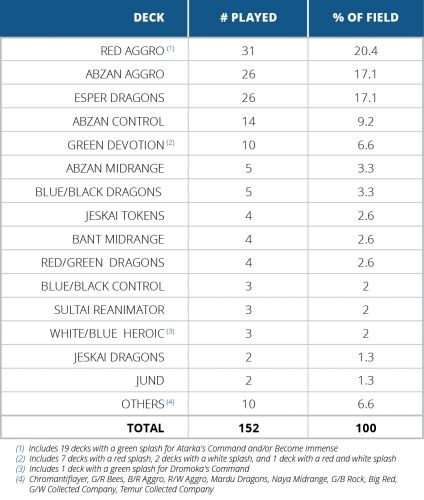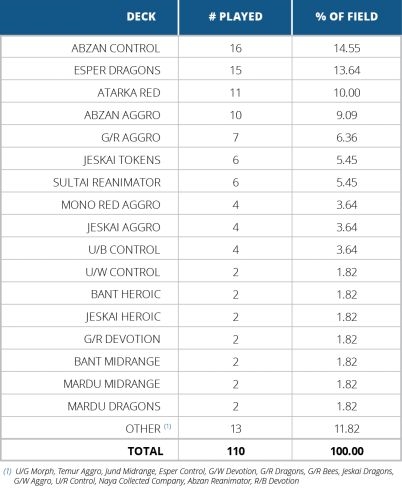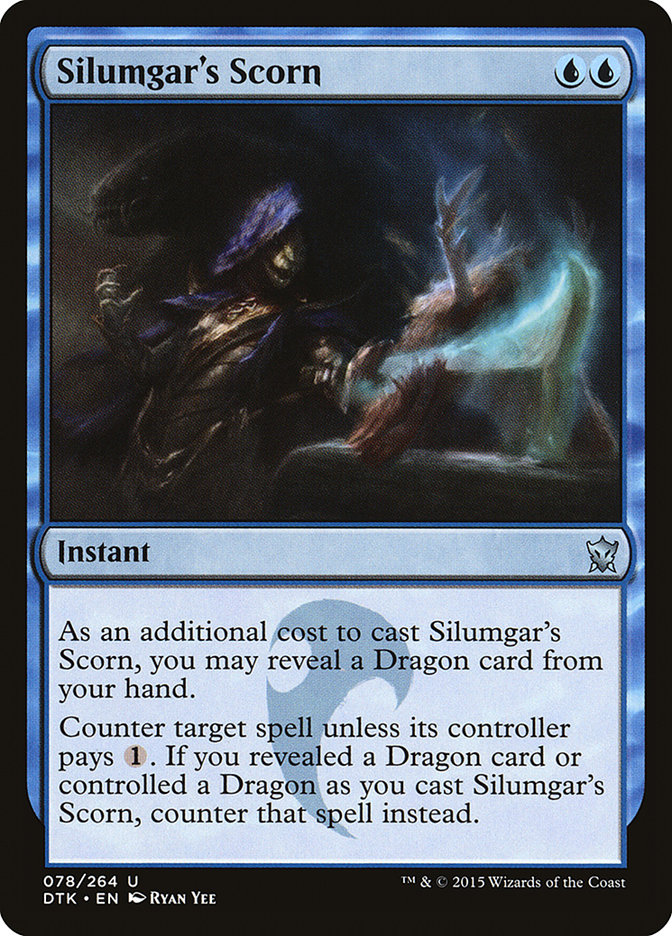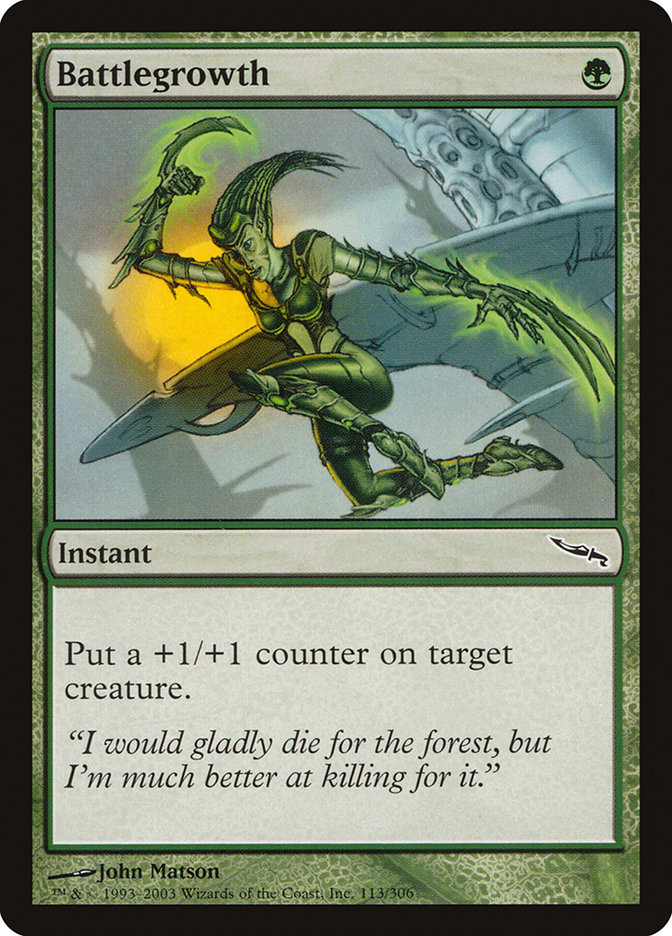This past weekend featured two separate large Standard events across the world from one another, but looking at the results of each, they seem like they
happened on different planets. Grand Prix Krakow and the Standard Open in Providence each put the new Dragons of Tarkir Standard format through its paces
and painted very different pictures of what to expect.
In the states, wunderkind Oliver Tomajko took down the Standard Open with Abzan Reanimator in a top 8 chock full of Siege Rhinos. In Krakow, there was not
a Sandsteppe Citadel to be seen, and all but two of the competitors in the elimination rounds were playing Dragonlord Ojutai! What’s going on?
Were there just far more Abzan pilots in Providence and far more people playing Esper in Krakow? Well, the difference was not a drastically different
representation in the metagame, it turns out. In fact, both events had a day two metagame breakdown that looked remarkably similar, with Esper Dragons,
Abzan Control, Abzan Aggro, and Red Aggro decks making up the four most commonly played day two decks in each event.
The Grand Prix

The Open Series

The more plausible explanation, I think, is that Grand Prix Krakow’s proximity to Pro Tour Dragons of Tarkir in Belgium meant that more of the Esper
Dragons pilots were better practiced with the deck. A significant number of pro players stuck around in Europe and made the trip to Poland after the Pro
Tour was over. Many of those players – who were part of my testing group – either played Esper Dragons in the Pro Tour itself, or spent a great deal of
time playing with or against the deck while preparing for the event.
Abzan is a deck that has been around for a while. While the subtleties of particular matchups may shift with new sets, the core strategy of the deck
generally remains the same. It’s not surprising to see a newer deck like Esper Dragons not have the same level of success in the hands of the players at
the Standard Open in Providence, players who have not had the same kind of time to practice with the deck as those playing in Krakow.
It’s also possible that Esper Dragons simply overperformed in Krakow due to the strength of its pilots. After all, players like Paulo Vitor Damo da Rosa
and Alexander Hayne are going to have an edge on most opponents almost no matter what they’re playing. Since Esper Dragons did so well at the Pro Tour,
even though it didn’t put any representatives into the Top 8, it may have drawn the attention of more of the best players in attendance at the Grand Prix,
making it all the more likely to rise to the top.
In any case, it’s clear that Esper Dragons is a strong deck, even if the weekend’s results can’t assure us just how strong. The same can clearly be said of
Abzan, but that’s a deck we’ve all seen time and again at this point. Let’s take a look at the new Standard bogeyman so we can break down its strengths
-and its weaknesses.
Creatures (5)
Planeswalkers (1)
Lands (27)
Spells (27)

While I haven’t played much with this deck, I played against it quite a bit in my preparation for the Pro Tour since it was what most of my testing
partners were leaning toward playing. The deck is quite powerful, and it has a wide variety of tools for dealing with whatever you can throw at it.
The card that is really at the core of the deck’s effectiveness is Silumgar’s Scorn. Counterspell has been considered too powerful to print for a long
time, and this is effectively exactly that as long as you have a Dragon to back it up. This deck only plays five Dragons, but it also has Anticipate and
Dig Through Time to find them. On top of that, Silumgar’s Scorn often doesn’t even need a Dragon in order to function as a counterspell. Often just the
Force Spike mode is enough to keep your opponent’s threats at bay when they’re playing on-curve. And if they try to wait until they have enough mana to pay
for Scorn, they’re not only giving you more time to find a Dragon, but also more time to develop your own mana, which this deck uses very well. Eventually
it can start actually playing those Dragons!
And when you get to that point, you can usually just tap out and play them! One of the most important features of Esper Dragons is how resilient it is
against removal effects. Unlike control decks that rely on planeswalkers like Elspeth or Narset, Esper Dragons is built around a core of hexproof win
conditions – Silumgar, the Drifting Death and Dragonlord Ojutai. This means that even the ever-versatile Hero’s Downfall is hard pressed to find a good
target. Sure, there is the occasional window in which Ojutai is vulnerable while he is attacking, but a skilled Esper Dragons pilot will rarely attack with
Ojutai into open mana without countermagic available unless they absolutely have to.
This ability to generate virtual card advantage is a really big deal. In a lot of matchups, your opponents will have essentially dead cards against you.
Against a deck like G/R Dragons, every Draconic Roar and Roast your opponent draws will rot in their hand. I played quite a bit against the Esper Dragon
deck with my G/W Aggro deck that I played at the Pro Tour ( and wrote about last week), and there was a direct correlation
between how many copies of Dromoka’s Command I drew and how likely I was to win the game. With all hexproof creatures, no damage-based removal, and no
enchantments, one of the strongest cards in my deck in most matchups essentially turned into a glorified Battlegrowth.
Not exactly a Constructed all-star.
Another strength of the deck is its ability to handle many things with which control decks frequently struggle. I spent a lot of time and mana to develop a
monstrous Fleecemane Lion on quite a few occasions during playtesting, only to lose my hexproof indestructible control slayer to Foul-Tongue Invocation –
while giving my opponent four life to boot. Token creatures – typically good against spot-removal heavy decks – die horribly to Bile Blight and the
Drifting Death. Between Hero’s Downfall and the hexproof Dragons, planeswalkers barely bother this deck, especially once Dragonlord Silumgar comes in from
the sideboard to make Nissa do his bidding instead.
This isn’t a grindy control deck by any means. Once Ojutai starts connecting, the snowball effect starts, as the Esper Dragons player repeatedly digs
deeper into their deck for more countermagic, card drawing, and removal to put the game away. Hitting for five damage each turn while generating both card
advantage and selection leads to absolutely running away with games once you get even the slightest bit ahead.
That phenomenon was part of why a number of us were skeptical about just how good this deck was heading into the Pro Tour. When it wins, it often does so
in incredibly decisive fashion, with a fist full of extra removal and countermagic thanks to Ojutai and Dig Through Time. This was a deck that led to quite
a few playtest games ending with one player simply revealing their hand and declaring victory in order to save time. I think that is part of the allure of
control decks to a lot of players. You spend a lot of time feeling like you’re winning, and that feels good.
Between the Pro Tour and Grand Prix Krakow, though, this deck has proven to be the real deal. You spend a lot of time winning not just because you’re in
firm control once you turn the corner, but because the deck is actually very strong and wins a lot. So what’s the best way to beat it?
Would you think my answer to that question would ever be anything other than attacking?
Look at that manabase. While Esper Dragons has quite a few cheap interactive spells, like Bile Blight, Ultimate Price, and Silumgar’s Scorn, it also has a
crazy number of lands that enter the battlefield tapped. That means it will frequently stumble trying to play spells on time, which in turn can leave the
deck vulnerable to early aggression. I know my teammates who played the deck at the Pro Tour wanted to avoid aggressive red decks, which can just come out
of the gates too quickly, especially in game ones before Drown in Sorrow is in the deck.
In my experience, one of the best ways to beat Esper Dragons is to make their mana usage awkward and inefficient while applying pressure. The single best
card in my G/W deck against them was Boon Satyr, because every aspect of it works extremely well against how their deck functions. It is great as a cheap,
high power threat to punish them for mana stumbles early. It is great against countermagic since you can just pass the turn when they leave mana open and
then cast it during their turn, forcing them to waste an entire turn’s worth of mana. It’s similarly great if they hold up that mana for a removal spell,
and it’s great to flash in at the end of your opponent’s turn after a Crux of Fate. It’s even great to bestow as a combat trick to force your creatures
through their Dragons, which can otherwise stymie some of your creatures’ attacks.
Deathmist Raptor is also a great card against the deck. It’s a threat that can attack past either of the Dragons thanks to deathtouch, and its ability to
return to play from the graveyard makes it line up very well against removal. In particular, the combination of Deathmist Raptor and Den Protector
alongside cheap high impact spells like Thoughtseize is a rough combination for the deck to beat.
I actually had a brief crisis of confidence in my deck the day before the Pro Tour and nearly switched to a deck that looked a lot like this:
Creatures (28)
- 4 Elvish Mystic
- 4 Boon Satyr
- 2 Heir of the Wilds
- 4 Rakshasa Deathdealer
- 3 Warden of the First Tree
- 4 Den Protector
- 4 Deathmist Raptor
- 3 Surrak, the Hunt Caller
Lands (24)
Spells (8)
Sideboard

There’s a part of me that wishes I’d made the last minute audible – mostly the part that remembers that I only won a single match of Standard at the Pro
Tour with the deck I did play. In the new Esper Dragons-filled metagame, though, I like the idea of this kind of deck even more. In addition to the Boon
Satyr and morph package we just discussed, this deck gets to play another serious headache for Esper Dragons. Raksasha Deathdealer is a cheap threat that
can dodge removal and can get absolutely huge late in the game. It represents an enormous amount of damage if left unchecked, and thanks to its ability to
regenerate, it’s not exactly easy to keep in check.
This list is very much raw and unrefined, but it is certainly something I’m interested in exploring further as this Standard format matures. The maindeck
is just lands, threats, and four each of Hero’s Downfall and Thoughtseize to keep the danger of dead cards against Esper Dragons to a minimum. The
sideboard, on the other hand, is full of cheap situational removal spells, which happen to work perfectly with Den Protector. There’s nothing quite like
killing your opponent’s creature for one mana twice in the first few turns of the game to swing the tempo. Against something like Green Devotion, you can
fill your entire deck with Ultimate Price and Hunt the Hunters that you can rebuy again and again – how are they supposed to win?
And against Esper Dragons, you get to swap out your largely dead Hero’s Downfalls for Duress and Collected Company. Remember what I said about Boon Satyr
being so good against Esper because of how it makes them use their mana inefficiently when you pass the turn? Collected Company works the same way while
offering potential value while you do it. This deck is a little bit shorter on great hits for Collected Company than I might like to play it in the
maindeck, but as a sideboard card I like it a lot against control.
If you want to go more all-out with Collected Company, there’s Bram Snepvangers deck from the Pro Tour:
Creatures (27)
- 4 Elvish Mystic
- 4 Reverent Hunter
- 4 Fleecemane Lion
- 4 Boon Satyr
- 3 Den Protector
- 4 Avatar of the Resolute
- 4 Surrak, the Hunt Caller
Lands (22)
Spells (11)

I can’t speak to all of the card choices here because this is Bram’s deck, not my own, but I definitely like the shell he has going here. Collected Company
actually works especially well alongside Bram’s Reverent Hunters since any hit helps increase your devotion. Reverent Hunter, in turn, helps fuel the +1/+1
counter theme of Avatar of the Resolute, which is the creature voted “most likely to surprise someone by having reach” by its peers. Both of those pair
quite well with Aspect of Hydra, which can win games out of nowhere on any unblocked creature, or just push damage past anything on an Avatar of the
Resolute – which will also likely catch them by surprise by having Trample.
I’m a little sad not to see any copies of Deathmist Raptor in here since it’s such a good hit with Collected Company and works so well with Den Protector,
but I can buy that Reverent Hunter represents a bigger threat in most matchups. I’d almost suggest cutting some number of spells and Surraks to fit them
in, but with both Collected Company and Boon Satyr in the deck, Surrak threatens to generate huge amounts of damage out of nowhere from an empty board.
This may be the best Surrak deck out there, so I’m a bit hesitant to take any copies out.
I would, however, strongly consider swapping one of the Dromoka’s Commands in the maindeck with one of the Valorous Stances in the sideboard, if only to
cut down ever so slightly on the potentially dead cards against control decks. While Valorous Stance isn’t amazing against Esper Dragons, it can at least
save one of your creatures from removal or threaten an attacking Ojutai, while Dromoka’s Command does virtually nothing.
I really can’t speak to the role of many of Bram’s other sideboard cards, though. I’m really curious to learn the idea behind Archetype of Courage because
it’s such an off-the-wall card that it seems like it must have a very specific purpose. Maybe he thought it was the best possible option against other
green creature decks – but even then I’m a little suspect that you’d rather have a difficult-to-cast double white cost creature that’s good in a long drawn
out game than something like Hunt the Hunter to win those games quickly. I’d also strongly consider playing Windstorm in the sideboard here since this deck
is just as vulnerable to Hornet Nest as every deck I ever seem to play – and without any fliers to go over it, which makes it even worse.
In any case, these two decks are the kind of directions I’m interested in exploring to tackle the new Esper Dragon menace; combining pressure, disruption,
and instant speed threats to punish the deck’s weaknesses. It’s quite likely that one of these will be what I bring to the first installment of the
Standard Super League next Tuesday on the official Magic Twitch channel – but don’t tell Brad I said that since he’s who I play in the first round.
What do you think? What are the Esper Dragon deck’s weaknesses, and what do you think are the best ways to exploit them?



